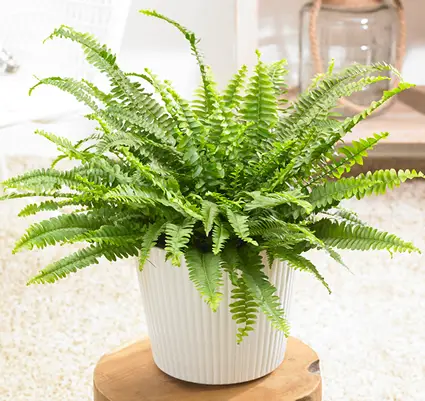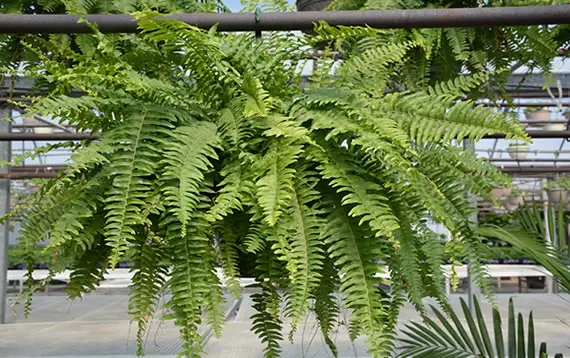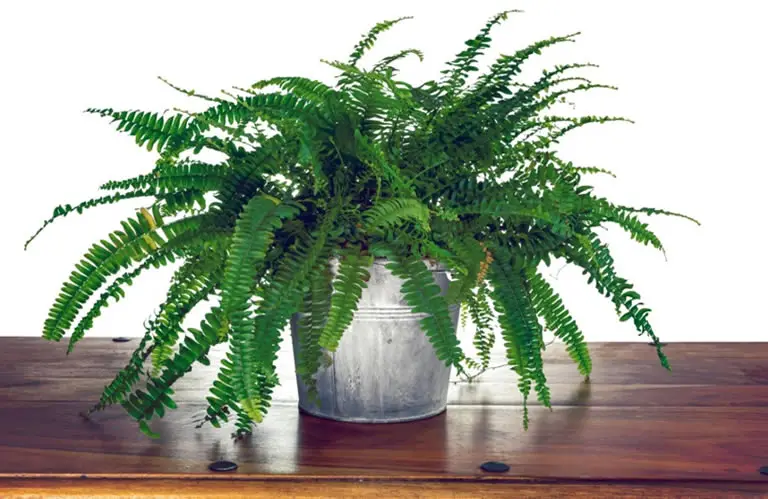The Boston Fern (Nephrolepis exaltata) is one of the most timeless and graceful houseplants you can grow. With its bright green, arching fronds and full, feathery texture, it brings a sense of softness and natural elegance to any room. It’s especially loved for its ability to clean the air and boost humidity—but it does have a few preferences to keep in mind if you want it looking its best.
Here’s everything you need to know to care for a Boston Fern indoors and outdoors, including how to avoid the most common problems that trip up even experienced plant lovers.
Table of Contents
- Bright, Filtered Light: What Boston Ferns Really Want Indoors
- Consistent Moisture: How and When to Water Your Fern
- Humidity Matters: Keeping Fronds Full and Lush
- Warm but Not Hot: The Best Temperature Range
- Feeding Routine: When and How to Fertilize
- Repotting Tips: Refreshing Soil Without Upsetting Roots
- Best Spot in the Home: Where Your Boston Fern Will Shine
- Caring for Boston Ferns Outdoors: Seasonal Tips for Lush Patio Plants
- Common Boston Fern Problems and How to Fix Them
- Final Thoughts
Bright, Filtered Light: What Boston Ferns Really Want Indoors
Boston Ferns grow best in bright, indirect light. A north or east-facing window is ideal, or a spot near a bright window with sheer curtains to soften the sun.

Direct sunlight can easily scorch the fronds, but too little light will leave the plant looking thin or dull.
If your fern isn’t as full or green as you’d like, lighting is the first thing to reassess.
Consistent Moisture: How and When to Water Your Fern
Boston Ferns like their soil to stay lightly moist, but never soggy.
Use a peat-based, well-draining mix and water thoroughly when the surface feels slightly dry.
During the warmer months, this could mean watering several times per week.
In winter, when growth slows, you can water less often—but never let the soil dry out completely.
If your fern is drying out quickly, consider switching to a self-watering pot or adding a humidity tray.
Humidity Matters: Keeping Fronds Full and Lush
This plant thrives in high humidity and may struggle in dry, heated homes—especially in winter.

Mist the fronds daily, use a humidifier, or place the pot on a pebble tray filled with water to maintain adequate moisture in the air.
Without enough humidity, you may notice browning leaf tips or fronds dropping altogether.
Warm but Not Hot: The Best Temperature Range
Boston Ferns prefer temperatures between 60°F and 75°F. Avoid placing them near heating vents, radiators, or drafty doors and windows.
They don’t tolerate temperature swings or dry air well, so choose a location with steady, mild conditions.
Feeding Routine: When and How to Fertilize
Feed your Boston Fern monthly during spring and summer with a diluted, balanced liquid fertilizer or one made specifically for ferns.
They’re light feeders, so go easy—too much fertilizer can lead to leaf burn and salt buildup.
Use a good quality 20-20-20 fertilizer, like this one or a 10-10-10 fertilizer, such as this one,
No need to fertilize during fall or winter.
Repotting Tips: Refreshing Soil Without Upsetting Roots
Boston Ferns prefer slightly snug pots, but their roots can become tangled and compacted over time.
Repot every one to two years, ideally in spring, into fresh, well-draining soil.
Choose a pot just one size larger and gently loosen the roots before replanting.
Best Spot in the Home: Where Your Boston Fern Will Shine
Boston Ferns are perfect for bathrooms, bright kitchens, or humid bedrooms with plenty of filtered light.
They also look stunning in hanging baskets where their arching fronds can spill gracefully over the edges.
Caring for Boston Ferns Outdoors: Seasonal Tips for Lush Patio Plants
Boston Ferns love spending time outdoors in warm weather.
They make excellent patio or porch plants in spring and summer, especially in hanging baskets or decorative containers.

Place them in a shaded or partially shaded spot outdoors where they’ll get protection from harsh midday sun and plenty of ambient humidity.
Be sure to water more frequently in the heat and check the soil daily if conditions are windy or dry.
Bring the plant back inside before nighttime temperatures drop below 50°F.
Always inspect for pests before reintroducing them to your indoor space.
Common Boston Fern Problems and How to Fix Them
Fronds turning brown or crispy
This is often due to low humidity, underwatering, or exposure to direct sun.
Fix it by increasing humidity around the plant, watering more consistently, and ensuring it’s kept out of strong light.
Yellowing leaves
Usually a sign of overwatering, poor drainage, or a lack of nutrients.
Fix it by checking your soil—make sure it’s not staying soggy, and fertilize if it’s been more than a month since the last feed.
Fronds dropping or thinning out
This could be caused by dry air, insufficient light, or inconsistent watering.
Fix it by misting more often, moving the plant to a brighter (indirect) light source, and establishing a steady watering routine.
Stunted growth or pale fronds
May be due to poor light, old soil, or a cramped root system.
Fix it by refreshing the soil, repotting if needed, and moving the fern closer to a filtered light source.
Pests like spider mites or scale
Boston Ferns can occasionally attract pests in dry conditions.
Fix it by gently rinsing the fronds in the shower, wiping leaves with a damp cloth, or applying neem oil or insecticidal soap.
Final Thoughts
Boston Ferns are among the most beautiful and rewarding plants to grow when you get their care routine just right.
They love moisture, humidity, and steady conditions—and when they’re happy, they show it with full, vibrant fronds that instantly soften and refresh any space.
Whether kept inside year-round or enjoyed outdoors during the warmer months, the Boston Fern is a living reminder of how lush and lively indoor gardening can be.

